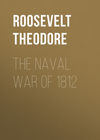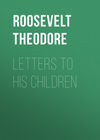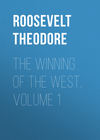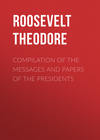Loe raamatut: «The Naval War of 1812»
ACKNOWLEDGMENTS
For their amiable and expert assistance in the selection of the illustrations in this volume, thanks are due to Mr. James W. Cheevers, curator of the U.S. Naval Academy Museum; Ms. Sigrid Trumpy, curator of the museum's Beverley R. Robinson Collection of naval prints; and Mrs. Patty Maddocks, director of the Naval Institute Library and Photographic Service.
JS
PREFACE
The history of the naval events of the War of 1812 has been repeatedly presented both to the American and the English reader. Historical writers have treated it either in connection with a general account of the contest on land and sea, or as forming a part of the complete record of the navies of the two nations. A few monographs, which confine themselves strictly to the naval occurrences, have also appeared. But none of these works can be regarded as giving a satisfactorily full or impartial account of the war—some of them being of he "popular" and loosely-constructed order, while others treat it from a purely partisan standpoint. No single book can be quoted which would be accepted by the modern reader as doing justice to both sides, or, indeed, as telling the whole story. Any one specially interested in the subject must read all; and then it will seem almost a hopeless task to reconcile the many and widely contradictory statements he will meet with.
There appear to be three works which, taken in combination, give the best satisfaction on the subject. First, in James' "Naval History of Great Britain" (which supplies both the material and the opinions of almost every subsequent English or Canadian historian) can be found the British view of the case. It is an invaluable work, written with fulness and care; on the other hand it is also a piece of special pleading by a bitter and not over-scrupulous partisan. This, in the second place, can be partially supplemented by Fenimore Cooper's "Naval History of the United States." The latter gives the American view of the cruises and battles; but it is much less of an authority than James', both because it is written without great regard for exactness, and because all figures for the American side need to be supplied from Lieutenant (now Admiral) George E. Emmons' statistical "History of the United States Navy," which is the third of the works in question.
But even after comparing these three authors, many contradictions remain unexplained, and the truth can only be reached in such cases by a careful examination of the navy "Records," the London "Naval Chronicle," "Niles' Register," and other similar documentary publications. Almost the only good criticisms on the actions are those incidentally given in standard works on other subjects, such as Lord Howard Douglass' "Naval Gunnery," and Admiral Jurien de la Gravière's "Guerres Maritimes." Much of the material in our Navy Department has never been touched at all. In short, no full, accurate, and unprejudiced history of the war has ever been written.
The subject merits a closer scrutiny than it has received. At present people are beginning to realize that it is folly for the great English-speaking Republic to rely for defence upon a navy composed partly of antiquated hulks, and partly of new vessels rather more worthless than the old. It is worth while to study with some care that period of our history during which our navy stood at the highest pitch of its fame; and to learn any thing from the past it is necessary to know, as near as may be, the exact truth. Accordingly the work should be written impartially, if only from the narrowest motives. Without abating a jot from one's devotion to his country and flag, I think a history can be made just enough to warrant its being received as an authority equally among Americans and Englishmen. I have endeavored to supply such a work. It is impossible that errors, both of fact and opinion, should not have crept into it; and although I have sought to make it in character as non-partisan as possible, these errors will probably be in favor of the American side.
As my only object is to give an accurate narrative of events, I shall esteem it a particular favor if any one will furnish me with the means of rectifying such mistakes; and if I have done injustice to any commander, or officer of any grade, whether American or British, I shall consider myself under great obligations to those who will set me right.
I have been unable to get access to the original reports of the British commanders, the logs of the British ships, or their muster-rolls, and so have been obliged to take them at second hand from the "Gazette," or "Naval Chronicle," or some standard history. The American official letters, log-books, original contracts, muster-rolls, etc., however, being preserved in the Archives at Washington, I have been able, thanks to the courtesy of the Hon. Wm. H. Hunt, Secretary of the Navy, to look them over. The set of letters from the officers is very complete, in three series,—"Captains' Letters," "Masters' Commandant Letters," and "Officers' Letters," there being several volumes for each year. The books of contracts contain valuable information as to the size and build of some of the vessels. The log-books are rather exasperating, often being very incomplete. Thus when I turned from Decatur's extremely vague official letter describing the capture of the Macedonian to the log-book of the Frigate United States, not a fact about the fight could be gleaned. The last entry in the log on the day of the fight is "strange sail discovered to be a frigate under English colors," and the next entry (on the following day) relates to the removal of the prisoners. The log of the Enterprise is very full indeed, for most of the time, but is a perfect blank for the period during which she was commanded by Lieutenant Burrows, and in which she fought the Boxer. I have not been able to find the Peacock's log at all, though there is a very full set of letters from her commander. Probably the fire of 1837 destroyed a great deal of valuable material. When ever it was possible I have referred to printed matter in preference to manuscript, and my authorities can thus, in most cases, be easily consulted. In conclusion I desire to express my sincerest thanks to Captain James D. Bulloch, formerly of the United States Navy, and Commander Adolf Mensing, formerly of the German Navy, without whose advice and sympathy this work would probably never have been written or even begun.
NEW YORK CITY, 1882.
PREFACE TO THIRD EDITION
I originally intended to write a companion volume to this, which should deal with the operations on land. But a short examination showed that these operations were hardly worth serious study. They teach nothing new; it is the old, old lesson, that a miserly economy in preparation may in the end involve a lavish outlay of men and money, which, after all, comes too late to more than partially offset the evils produced by the original short-sighted parsimony. This might be a lesson worth dwelling on did it have any practical bearing on the issues of the present day; but it has none, as far as the army is concerned. It was criminal folly for Jefferson, and his follower Madison, to neglect to give us a force either of regulars or of well-trained volunteers during the twelve years they had in which to prepare for the struggle that any one might see was inevitable; but there is now far less need of an army than there was then. Circumstances have altered widely since 1812. Instead of the decaying might of Spain on our southern frontier, we have the still weaker power of Mexico. Instead of the great Indian nations of the interior, able to keep civilization at bay, to hold in check strong armies, to ravage large stretches of territory, and needing formidable military expeditions to overcome them, there are now only left broken and scattered bands, which are sources of annoyance merely. To the north we are still hemmed in by the Canadian possessions of Great Britain; but since 1812 our strength has increased so prodigiously, both absolutely and relatively, while England's military power has remained almost stationary, that we need now be under no apprehensions from her land-forces; for, even if checked in the beginning, we could not help conquering in the end by sheer weight of numbers, if by nothing else. So that there is now no cause for our keeping up a large army; while, on the contrary, the necessity for an efficient navy is so evident that only our almost incredible short-sightedness prevents our at once preparing one.
Not only do the events of the war on land teach very little to the statesman who studies history in order to avoid in the present the mistakes of the past, but besides this, the battles and campaigns are of little interest to the student of military matters. The British regulars, trained in many wars, thrashed the raw troops opposed to them whenever they had any thing like a fair chance; but this is not to be wondered at, for the same thing has always happened the world over under similar conditions. Our defeats were exactly such as any man might have foreseen, and there is nothing to be learned from the follies committed by incompetent commanders and untrained troops when in the presence of skilled officers having under them disciplined soldiers. The humiliating surrenders, abortive attacks, and panic routs of our armies can all be paralleled in the campaigns waged by Napoleon's marshals against the Spaniards and Portuguese in the years immediately preceding the outbreak of our own war. The Peninsular troops were as little able to withstand the French veterans as were our militia to hold their own against the British regulars. But it must always be remembered, to our credit, that while seven years of fighting failed to make the Spaniards able to face the French,[Footnote: At the closing battle of Toulouse, fought between the allies and the French, the flight of the Spaniards was so rapid and universal as to draw from the Duke of Wellington the bitter observation, that "though he had seen a good many remarkable things in the course of his life, yet this was the first time he had ever seen ten thousand men running a race."] two years of warfare gave us soldiers who could stand against the best men of Britain. On the northern frontier we never developed a great general,—Brown's claim to the title rests only on his not having committed the phenomenal follies of his predecessors,—but by 1814 our soldiers had become seasoned, and we had acquired some good brigade commanders, notably Scott, so that in that year we played on even terms with the British. But the battles, though marked by as bloody and obstinate fighting as ever took place, were waged between small bodies of men, and were not distinguished by any feats of generalship, so that they are not of any special interest to the historian. In fact, the only really noteworthy feat of arms of the war took place at New Orleans, and the only military genius that the struggle developed was Andrew Jackson. His deeds are worthy of all praise, and the battle he won was in many ways so peculiar as to make it well worth a much closer study than it has yet received. It was by far the most prominent event of the war; it was a victory which reflected high honor on the general and soldiers who won it, and it was in its way as remarkable as any of the great battles that took place about the same time in Europe. Such being the case, I have devoted a chapter to its consideration at the conclusion of the chapters devoted to the naval operations.
As before said, the other campaigns on land do not deserve very minute attention; but, for the sake of rendering the account of the battle of New Orleans more intelligible, I will give a hasty sketch of the principal engagements that took place elsewhere.
The war opened in mid-summer of 1812, by the campaign of General Hull on the Michigan frontier. With two or three thousand raw troops he invaded Canada. About the same time Fort Mackinaw was surrendered by its garrison of 60 Americans to a British and Indian force of 600. Hull's campaign was unfortunate from the beginning. Near Brownstown the American Colonel Van Horne, with some 200 men, was ambushed and routed by Tecumseh and his Indians. In revenge Col. Miller, with 600 Americans, at Maguaga attacked 150 British and Canadians under Capt. Muir, and 250 Indians under Tecumseh, and whipped them,—Tecumseh's Indians standing their ground longest. The Americans lost 75, their foes 180 men. At Chicago the small force of 66 Americans was surprised and massacred by the Indians. Meanwhile, General Brock, the British commander, advanced against Hull with a rapidity and decision that seemed to paralyze his senile and irresolute opponent. The latter retreated to Detroit, where, without striking a blow, he surrendered 1,400 men to Brock's nearly equal force, which consisted nearly one half of Indians under Tecumseh. On the Niagara frontier, an estimable and honest old gentleman and worthy citizen, who knew nothing of military matters, Gen. Van Rensselaer, tried to cross over and attack the British at Queenstown; 1,100 Americans got across and were almost all killed or captured by a nearly equal number of British, Canadians, and Indians, while on the opposite side a large number of their countrymen looked on, and with abject cowardice refused to cross to their assistance. The command of the army was then handed over to a ridiculous personage named Smythe, who issued proclamations so bombastic that they really must have come from an unsound mind, and then made a ludicrously abortive effort at invasion, which failed almost of its own accord. A British and Canadian force of less than 400 men was foiled in an assault on Ogdensburg, after a slight skirmish, by about 1,000 Americans under Brown; and with this trifling success the military operations of the year came to an end.
Early in 1813, Ogdensburg was again attacked, this time by between 500 and 600 British, who took it after a brisk resistance from some 300 militia; the British lost 60 and the Americans 20, in killed and wounded. General Harrison, meanwhile, had begun the campaign in the Northwest. At Frenchtown, on the river Raisin, Winchester's command of about 900 Western troops was surprised by a force of 1,100 men, half of them Indians, under the British Colonel Proctor. The right division, taken by surprise, gave up at once; the left division, mainly Kentucky riflemen, and strongly posted in houses and stockaded enclosures, made a stout resistance, and only surrendered after a bloody fight, in which 180 British and about half as many Indians were killed or wounded. Over 300 Americans were slain, some in battle, but most in the bloody massacre that followed. After this, General Harrison went into camp at Fort Meigs, where, with about 1,100 men, he was besieged by 1,000 British and Canadians under Proctor and 1,200 Indians under Tecumseh. A force of 1,200 Kentucky militia advanced to his relief and tried to cut its way into the fort while the garrison made a sortie. The sortie was fairly successful, but the Kentuckians were scattered like chaff by the British regulars in the open, and when broken were cut to pieces by the Indians in the woods. Nearly two thirds of the relieving troops were killed or captured; about 400 got into the fort. Soon afterward Proctor abandoned the siege. Fort Stephenson, garrisoned by Major Croghan and 160 men, was attacked by a force of 391 British regulars, who tried to carry it by assault, and were repulsed with the loss of a fourth of their number. Some four thousand Indians joined Proctor, but most of them left him after Perry's victory on Lake Erie. Then Harrison, having received large reinforcements, invaded Canada. At the River Thames his army of 3,500 men encountered and routed between 600 and 700 British under Proctor, and about 1,000 Indians under Tecumseh. The battle was decided at once by a charge of the Kentucky mounted riflemen, who broke through the regulars, took them in rear, and captured them, and then dismounting attacked the flank of the Indians, who were also assailed by the infantry. Proctor escaped by the skin of his teeth and Tecumseh died fighting, like the hero that he was. This battle ended the campaign in the Northwest. In this quarter it must be remembered that the war was, on the part of the Americans, mainly one against Indians; the latter always forming over half of the British forces. Many of the remainder were French Canadians, and the others were regulars. The American armies, on the contrary, were composed of the armed settlers of Kentucky and Ohio, native Americans, of English speech and blood, who were battling for lands that were to form the heritage of their children. In the West the war was only the closing act of the struggle that for many years had been waged by the hardy and restless pioneers of our race, as with rifle and axe they carved out the mighty empire that we their children inherit; it was but the final effort with which they wrested from the Indian lords of the soil the wide and fair domain that now forms the heart of our great Republic. It was the breaking down of the last barrier that stayed the flood of our civilization; it settled, once and for ever, that henceforth the law, the tongue, and the blood of the land should be neither Indian, nor yet French, but English. The few French of the West were fighting against a race that was to leave as little trace of them as of the doomed Indian peoples with whom they made common cause. The presence of the British mercenaries did not alter the character of the contest; it merely served to show the bitter and narrow hatred with which the Mother-Island regarded her greater daughter, predestined as the latter was to be queen of the lands that lay beyond the Atlantic.
Meanwhile, on Lake Ontario, the Americans made successful descents on York and Fort George, scattering or capturing their comparatively small garrisons; while a counter descent by the British on Sackett's Harbor failed, the attacking force being too small. After the capture of Fort George, the Americans invaded Canada; but their advance guard, 1,400 strong, under Generals Chandler and Winder, was surprised in the night by 800 British, who, advancing with the bayonet, broke up the camp, capturing both the generals and half the artillery. Though the assailants, who lost 220 of their small number, suffered much more than the Americans, yet the latter were completely demoralized, and at once retreated to Fort George. Soon afterward, Col. Boerstler with about 600 men surrendered with shamefully brief resistance to a somewhat smaller force of British and Indians. Then about 300 British crossed the Niagara to attack Black Rock, which they took, but were afterward driven off by a large body of militia with the loss of 40 men. Later in the season the American General McClure wantonly burned the village of Newark, and then retreated in panic flight across the Niagara. In retaliation the British in turn crossed the river; 600 regulars surprised and captured in the night Fort Niagara, with its garrison of 400 men; two thousand troops attacked Black Rock, and after losing over a hundred men in a smart engagement with somewhat over 1,500 militia whom they easily dispersed, captured and burned both it and Buffalo. Before these last events took place another invasion of Canada had been attempted, this time under General Wilkinson, "an unprincipled imbecile," as Scott very properly styled him. It was mismanaged in every possible way, and was a total failure; it was attended with but one battle, that of Chrystler's Farm, in which 1,000 British, with the loss of less than 200 men, beat back double their number of Americans, who lost nearly 500 men and also one piece of artillery. The American army near Lake Champlain had done nothing, its commander, General Wade Hampton, being, if possible, even more incompetent than Wilkinson. He remained stationary while a small force of British plundered Plattsburg and Burlington; then, with 5,000 men he crossed into Canada, but returned almost immediately, after a small skirmish at Chauteaugay between his advance guard and some 500 Canadians, in which the former lost 41 and the latter 22 men. This affair, in which hardly a tenth of the American force was engaged, has been, absurdly enough, designated a "battle" by most British and Canadian historians. In reality it was the incompetency of their general and not the valor of their foes that caused the retreat of the Americans. The same comment, by the way, applies to the so-called "Battle" of Plattsburg, in the following year, which may have been lost by Sir George Prevost, but was certainly not won by the Americans. And, again, a similar criticism should be passed on General Wilkinson's attack on La Colle Mill, near the head of the same lake. Neither one of the three affairs was a stand-up fight; in each a greatly superior force, led by an utterly incapable general, retreated after a slight skirmish with an enemy whose rout would have been a matter of certainty had the engagement been permitted to grow serious.
In the early spring of 1814 a small force of 160 American regulars, under Captain Holmes, fighting from behind felled logs, routed 200 British with a loss of 65 men, they themselves losing but 8. On Lake Ontario the British made a descent on Oswego and took it by fair assault; and afterward lost 180 men who tried to cut out some American transports, and were killed or captured to a man. All through the spring and early summer the army on the Niagara frontier was carefully drilled by Brown, and more especially by Scott, and the results of this drilling were seen in the immensely improved effectiveness of the soldiers in the campaign that opened in July. Fort Erie was captured with little resistance, and on the 4th of July, at the river Chippeway, Brown, with two brigades of regulars, each about 1,200 strong, under Scott and Ripley, and a brigade of 800 militia and Indians under Porter, making a total of about 3,200 men, won a stand-up fight against the British General Riall, who had nearly 2,500 men, 1,800 of them regulars. Porter's brigade opened by driving in the Canadian militia and the Indians; but was itself checked by the British light-troops. Ripley's brigade took very little part in the battle, three of the regiments not being engaged at all, and the fourth so slightly as to lose but five men. The entire brunt of the action was borne by Scott's brigade, which was fiercely attacked by the bulk of the British regulars under Riall. The latter advanced with great bravery, but were terribly cut up by the fire of Scott's regulars; and when they had come nearly up to him, Scott charged with the bayonet and drove them clean off the field. The American loss was 322, including 23 Indians; the British loss was 515, excluding that of the Indians. The number of Americans actually engaged did not exceed that of the British; and Scott's brigade, in fair fight, closed by a bayonet charge, defeated an equal force of British regulars.
On July 25th occurred the Battle of Niagara, or Lundy's Lane, fought between General Brown with 3,100 [Footnote: As near as can be found out; most American authorities make it much less; Lossing, for example, says only 2,400.] Americans and General Drummond with 3,500 [Footnote: General Drummond in his official letter makes it but 2,800; James, who gives the details, makes it 3,000 rank and file; adding 13 per cent, for the officers, sergeants, and drummers, brings it up to 3,400; and we still have to count in the artillery drivers, etc.] British. It was brought on by accident in the evening, and was waged with obstinate courage and savage slaughter till midnight. On both sides the forces straggled into action by detachments. The Americans formed the attacking party. As before, Scott's brigade bore the brunt of the fight, and over half of his men were killed or wounded; he himself was disabled and borne from the field. The struggle was of the most desperate character, the combatants showing a stubborn courage that could not be surpassed. [Footnote: General Drummond writes: "In so determined a manner were their attacks directed against our guns that our artillerymen were bayoneted while in the act of loading, and the muzzle of the enemy's guns were advanced within a few yards of ours." Even James says: "Upon the whole, however, the American troops fought bravely; and the conduct of many of the officers, of the artillery corps especially, would have done honor to any service."] Charge after charge was made with the bayonet, and the artillery was taken and retaken once and again. The loss was nearly equal; on the side of the Americans, 854 men (including Generals Brown and Scott, wounded) and two guns; on that of the British, 878 men (including General Riall captured) and one gun. Each side claimed it as a victory over superior numbers. The truth is beyond question that the British had the advantage in numbers, and a still greater advantage in position; while it is equally beyond question that it was a defeat and not a victory for the Americans. They left the field and retired in perfect order to Fort Erie, while the British held the field and the next day pursued their foes.
Having received some reinforcements General Drummond, now with about 3,600 men, pushed forward to besiege Fort Erie, in which was the American army, some 2,400 strong, under General Gaines. Col. Tucker with 500 British regulars was sent across the Niagara to destroy the batteries at Black Rock, but was defeated by 300 American regulars under Major Morgan, fighting from behind a strong breastwork of felled trees, with a creek in front. On the night of the 15th of August, the British in three columns advanced to storm the American works, but after making a most determined assault were beaten off. The assailants lost 900 men, the assailed about 80. After this nothing was done till Sept. 17th, when General Brown, who had resumed command of the American forces, determined upon and executed a sortie. Each side had received reinforcements; the Americans numbered over 3,000, the British nearly 4,000. The fighting was severe, the Americans losing 500 men; but their opponents lost 600 men, and most of their batteries were destroyed. Each side, as usual, claimed the victory; but, exactly as Lundy's Lane must be accounted an American defeat, as our forces retreated from the ground, so this must be considered an American victory, for after it the British broke up camp and drew off to Chippeway. Nothing more was done, and on November 5th the American army recrossed the Niagara. Though marked by some brilliant feats of arms this four months' invasion of Canada, like those that had preceded it, thus came to nothing. But at the same time a British invasion of the United States was repulsed far more disgracefully. Sir George Prevost, with an army of 13,000 veteran troops, marched south along the shores of Lake Champlain to Plattsburg, which was held by General Macomb with 2,000 regulars, and perhaps double that number of nearly worthless militia;—a force that the British could have scattered to the winds, though, as they were strongly posted, not without severe loss. But the British fleet was captured by Commodore MacDonough in the fight on the lake; and then Sir George, after some heavy skirmishing between the outposts of the armies, in which the Americans had the advantage, fled precipitately back to Canada.
All through the war the sea-coasts of the United States had been harried by small predatory excursions; a part of what is now the State of Maine was conquered with little resistance, and kept until the close of hostilities; and some of the towns on the shores of Chesapeake Bay had been plundered or burnt. In August, 1814, a more serious invasion was planned, and some 5,000 troops—regulars, sailors, and marines—were landed, under the command of General Ross. So utterly helpless was the Democratic Administration at Washington, that during the two years of warfare hardly any steps had been taken to protect the Capitol, or the country round about; what little was done, was done entirely too late, and bungled badly in addition. History has not yet done justice to the ludicrous and painful folly and stupidity of which the government founded by Jefferson, and carried on by Madison, was guilty, both in its preparations for, and in its way of carrying on, this war; nor is it yet realized that the men just mentioned, and their associates, are primarily responsible for the loss we suffered in it, and the bitter humiliation some of its incidents caused us. The small British army marched at will through Virginia and Maryland, burned Washington, and finally retreated from before Baltimore and reembarked to take part in the expedition against New Orleans. Twice, at Bladensburg and North Point, it came in contact with superior numbers of militia in fairly good position. In each case the result was the same. After some preliminary skirmishing, manoeuvring, and volley firing, the British charged with the bayonet. The rawest regiments among the American militia then broke at once; the others kept pretty steady, pouring in quite a destructive fire, until the regulars had come up close to them, when they also fled. The British regulars were too heavily loaded to pursue, and, owing to their mode of attack, and the rapidity with which their opponents ran away, the loss of the latter was in each case very slight. At North Point, however, the militia, being more experienced, behaved better than at Bladensburg. In neither case were the British put to any trouble to win their victory.



















